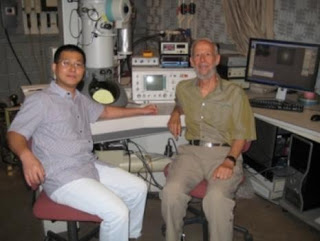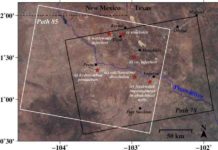
High pressures and temperatures cause materials to exhibit unusual properties, some of which can be special. Understanding such new properties is important for developing new materials for desired industrial uses and also for understanding the interior of Earth, where everything is hot and squeezed.
A paper in Nature Geoscience highlights a new technique in which small amounts of a sample can be studied while being hot and squeezed within an electron microscope. Use of such a microscopy method permits determination of details down to the scale of a few atoms, including the detection of unexpected atom types or atoms in unexpected places, as within a mineral.
Jun Wu and Peter Buseck, the paper’s authors, both at Arizona State University, conducted the research on campus at the J.M. Cowley Center for High Resolution Electron Microscopy of the LeRoy Eyring Center for Solid State Science. The researchers used tiny containers of carbon, less than one-thousandth the width of a human hair and therefore small enough to fit within high-resolution electron microscopes, to enclose materials similar to those deep within Earth. They then used the electron beam to shrink and thereby squeeze these minuscule capsules. When combined with heating of the samples, new features were observed in the enclosed materials.
“Under such high pressures and temperatures, the materials inside the capsules developed faults that concentrated carbon along them,” explains Buseck, Regents’ Professor in the Department of Chemistry and Biochemistry and the School of Earth and Space Exploration.
The Nature Geoscience paper describes the use of this new method to address the important problem of how and where carbon is located within Earth’s interior. Carbon is an essential building block for all forms of life and it also has important effects on climate and climate change through greenhouses gases such as carbon dioxide and carbon tetrahydride, also known as natural gas or methane.
The largest single reservoir for carbon is within Earth’s interior. However, the known hosts for this carbon are believed to be insufficient to explain the amounts present.
Because Earth’s interior (as well as the interiors of other planets) contains vast amounts of materials like those used in the experiments, the scientists conclude that such faults, and the carbon they concentrate, provide a solution to the problem of explaining where large amounts of carbon reside in Earth’s interior.
Wu and Buseck’s experiments also demonstrate a new way of studying materials at high pressure and temperature within an electron microscope, thereby significantly extending the tools available to scientists for examining materials under extreme conditions.
Note : The above story is based on materials provided by Arizona State University.










